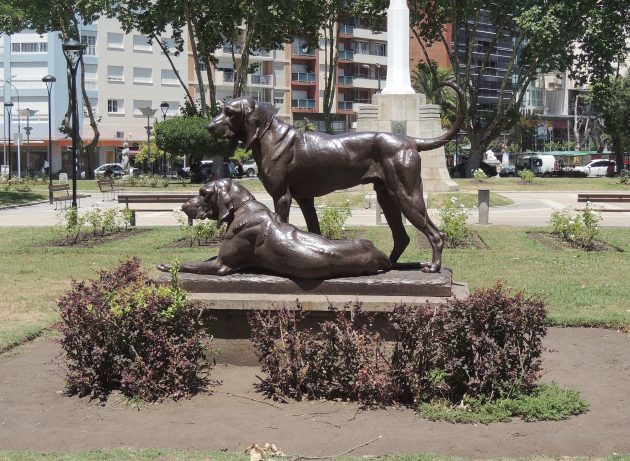
The highly descriptive poem which follows below was written by Emile Hizelin, and inspired by the sculpture seen below it.
“The two hunting dogs are tied in undergrowth.
One, on the damp earth, gives in to dreams,
The other is standing, watching, and suddenly he shudders
There he listens to some vague barking.
It’s hunting! The hunt with its furious voices
The trembling horses fly, the horn sounds,
And all follow a pale and superb Amazon
On a golden whip clenching her fair fingers.
The hunt runs off like a gust.
In the eyes of the two dogs passed, triumphant,
The clear vision of the new kills,
They thought they saw the beast already torn,
And in the evening, in the courtyard, under red torches
The thousand teeth orgy of the hot spoils.”

The sculpture called, “Hunting Dogs” was created by Hizelin’s friend, Camille Gaté.
As for Gaté’s talent, they never saw it coming.
Camille Gaté was twenty-eight years old before he sculpted anything, let alone portraits of a couple of employees who worked in his family’s modest tannery business. Camille was probably expected to stay in the family business, but the two terracotta figures he depicted were so remarkably good that the notion of Camille doing anything but sculpt was probably dismissed or forgotten, but we can’t say for sure because there is scant information about the man. As for the sculpted portraits, they are now preserved in the castle of Nogent-le-Rotrou.
One of Gaté’s first sculptures was “Chiens de Relais,” or “Hunting Dogs.” The piece was executed in plaster in 1885 for the Salon des Artistes Français, the official art exhibition of the Académie des Beaux-Arts in Paris, and arguably the greatest annual event in the Western world between 1748 and 1890. It was so well received that it was cast in bronze the following year and presented at the World’s Fair of 1889 in Paris (along with the Eiffel Tower). The sculpture, in fact, earned Gaté the status of Officer of the Academy, a big deal.
Gaté’s attention to the dogs’ musculature and bone structure is noteworthy, and we encourage you to click here and here to see better photographs of the piece. The breed of the dogs rendered in the monumental cast iron statue have usually been described as Bloodhounds, but they are, in fact, a pair of Grand Bleus de Gascogne, the breed of hunting dogs employed in the royal packs of Henri IV. It probably isn’t surprising that Gaté chose this breed as he was known to be passionate about the medieval past of his hometown, Nogent-le-Rotrou.

Copy of “Hunting Dogs” by Camille Gaté at Mar del Plata, Argentina. Photo shared under CC BY-SA 3.0 license
Duplicates of the sculpture are present in two places of Nogent-le-Rotrou, the Place de la République, and the garden of the Chateau Saint-Jean. In Joinville-le-Vallage, the beautiful cast by Durenne and the Val d’Osne (dated 1953) was installed in the municipal park. It may also be seen at the Mar del Plata in the province of Buenos Aires, Argentina seen here at the side.
You can inquire about the price of having your own cast of the sculpture by emailing the Marc Maison Gallery here (and tell us if you get an answer, we’re curious!)
The UKC Grand Bleus de Gascogne breed standard may be read here.
Camille Gaté died in 1900 in the same town in which he was born.
Top image of two Grand Bleu de Gascogne youngsters by © Slowmotiongli | dreamstime stock photo
